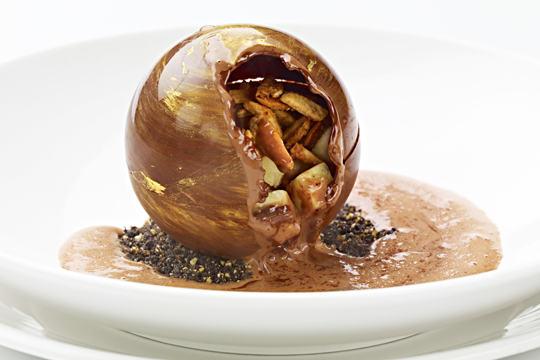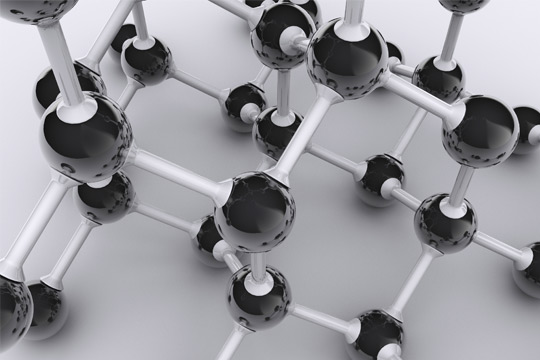
Reducing Food Waste in Foodservice
October 16, 2018 by Doreen Garelick, Dietetic Intern
Our intern Doreen attended a food waste summit for restaurants and compiled these tips to help food service operators redirect…
Nutrition 101
April 2, 2013

Dietetic Intern Tim Chin discusses the rise in popularity of culinary alchemy and whether it has any bearing on your health.
When it comes to food and so-called "avant-garde cuisine", the term molecular gastronomy -- a type of food science involving the way in which a certain ingredient’s chemical structure may change during cooking -- is a polarizing idea. At its best, the practice evokes the ethereal: frothy lobster foams, fruit caviar, liquid nitrogen or hot ice cream, peanut butter powder, and -- a personal favorite – pliable twists of chocolate ganache. At its worst, molecular gastronomy produces food downright unfit for consumption (I will refrain from an in-depth diatribe against deconstructed steak tartare) often owing to the ambitions of chefs too eager to impress.
Culinary successes and failures aside, molecular gastronomy continues to offer an alternative paradigm for how we prepare food, and it is here to stay. But is it healthy? Is it practical? Does such culinary alchemy hold any place in the preparation of nutritionally sound food?
 © Orla | Dreamstime Stock Photos & Stock Free Images
© Orla | Dreamstime Stock Photos & Stock Free Images
As it turns out, the answer is yes. And here’s why:
In 1988, Nicholas Kurti and Hervé coined the term molecular gastronomy as the study of culinary transformations from a physical and chemical perspective. Their goal was to provide alternatives to or expansions upon the classical French techniques popularized by Georges Auguste Escoffier – the father of French cookery. Contrary to popular belief, many -- if not most -- of the ingredients involved in these alternative techniques are not artificial. In fact, the majority of emulsifiers and thickeners used in the culinary industry are derived from plants and animals.
Kurti and Hervé break molecular gastronomy into several subdivisions for culinary application including foams, freezing, dehydrating, sous‐vide, spherification, enzymatic action, sugar substitutes, emulsifiers and hydrocolloids among a litany of others. As it turns out, emulsifiers and hydrocolloids prove immensely useful for the preparation of foods that are lower in saturated fat, added sugar, dairy, and even cholesterol. Let’s take a look:
An emulsion is a mixture of two immiscible liquids (liquids that will not typically mix together) – chiefly fat and water. By vigorous mixing and the addition of an emulsifier, the two phases can combine to form a stable system that stays mixed for a period of time. Examples of emulsions include dressings, vinaigrettes, mayonnaise and even milk. If you ever leave a bottle of homemade Italian dressing out, you may see the liquids start to separate. This separation of water and oil occurs because energy – in the form of mechanical mixing or shaking – is required to keep the emulsion stable. But if you add mustard to your vinaigrette, you will see that your dressing stays emulsified for much longer. Simply put, the mustard acts as an emulsifier – increasing kinetic stability and keeping the vinegar (which is mostly water) well dispersed in the oil.
The most common emulsifiers used in the kitchen are egg yolks, mustard, and -- to a lesser extent -- soy lecithin. In particular, soy lecithin provides immense benefit in the production of foods lower in cholesterol and saturated fat. For instance, soy lecithin is often used in baking as cheap alternative to eggs as a binding agent in enriched dough, thereby lowering fat and cholesterol content of products. Moreover, the primary emulsifying agent in egg yolks is lecithin, so soy lecithin serves as a suitable alternative. Of course, you can’t replace the exact flavor and richness of egg yolks in baked goods. But when used as an additive, soy lecithin helps to cut down on the amount of egg yolk needed to yield a quality product.
Soy lecithin is plant-derived and easily digestible. And as an added benefit, the trace isoflavones found in soy products have been suggested experimentally to lower LDL levels, reduce risk of coronary heart disease and serve as potent antioxidants.
In cooking, hydrocolloids refer to the class of gums and polysaccharides that thicken liquid emulsions. Specifically, a hydrocolloid is anything that forms a gel with water. These compounds range from more household products such as gelatin, cornstarch and apple pectin to more exotic names such as agar agar, carrageenan, gellan, guar gum, xanthan gum, methyl cellulose, isomalt and maltodextrin. Even lecithin serves as a type of hydrocolloid.
Like lecithin, most of these compounds are plant-‐derived and are readily digestible. Xanthan gum may be derived from corn or whey, and it is used extensively to stabilize or thicken sauces instead of butter or a typical flour and fat based roux. Agar has been used in Asian cuisine for decades despite only recently becoming popular in western cooking as a gelling agent. Once again, the majority of these hydrocolloids can take the place of eggs, butter, and starch when thickening sauces, custards, curds and the like.
In some cases, the texture and mouth feel of products containing hydrocolloids are just as good as – if not better than – their more traditional counterparts. For instance, using milk, sugar, a good vanilla bean and just a few grams of carrageenan in place of eggs, you could make a vanilla pudding that is unctuous, smooth, and creamy with virtually no added fat, calories or cholesterol from eggs!
For better or for worse, molecular gastronomy is here to stay in the culinary world. And despite any popular doubt, scientific cooking has a place in developing healthy, nutritious cuisine. The hard truth is that the gums, powders, extracts, and emulsifiers so ubiquitous in experimental cuisine have been in our food for the better part of a century – as additives in manufactured food products or unwittingly as ingredients in our grandmother’s kitchen. In the end, all cooking relies on at least a rudimentary understanding of physics and chemistry, and as we try to understand more about cooking, the more we must understand the science behind it.
Molecular cooking is nothing more than a lens through which we look at how we make food. So why not embrace it and use it to our advantage?
Bring on the eggless chocolate pudding cake, I’d say. Just hold the deconstructed steak tartare.
Works Cited
Kohajdová, Zlatica, Jolana Karovičová, and Štefan Schmidt. "Significance of Emulsifiers and Hydrocolloids in Bakery Industry." Acta Chimica Slovaca 2.1 (2009): 46-‐61. Print.
Lersch, Martin. "Hydrocolloid recipe collection edited by Martin Lersch” (n.d.): n. pag. Khymos. May 2010. Web. 28 Mar. 2013.
McGee, Harold. On Food and Cooking: The Science and Lore of the Kitchen. New York: Scribner, 2004. Print.
Yek, Grace S., and Kurt Struwe. "Deconstructing Molecular Gastronomy."Foodtechnology. N.p., June 2008. Web. 28 Mar. 2013.

October 16, 2018 by Doreen Garelick, Dietetic Intern
Our intern Doreen attended a food waste summit for restaurants and compiled these tips to help food service operators redirect food waste from landfills.
Nutrition 101

Nutrition 101
September 26, 2018 by Doreen Garelick, Dietetic Intern
Ever notice headlines about rapid weightloss? Dietetic Intern Doreen Garelick looks deeper into a recent eye-catching headline to see if there's any truth behind it.
Connect
 Follow us on Twitter
Follow us on Twitter Friend us on Facebook
Friend us on Facebook Follow us on Pinterest
Follow us on Pinterest Follow us on Instagram
Follow us on Instagram Read our Blog
Read our Blog Watch videos on YouTube
Watch videos on YouTube Watch videos on Vimeo
Watch videos on Vimeo Connect with us on Linkedin
Connect with us on Linkedin Find us on Foursquare
Find us on Foursquare
Tweets by @SPEcertifiedBlog Search
Categories
SPE Certified Newsletter
Sign up for news on the latest SPE-certified venues, events and SPE updates.
We will never share your personal information with a third party.